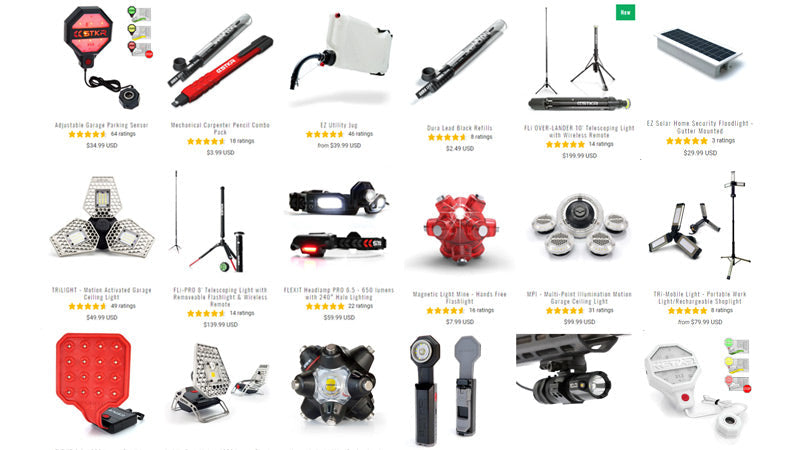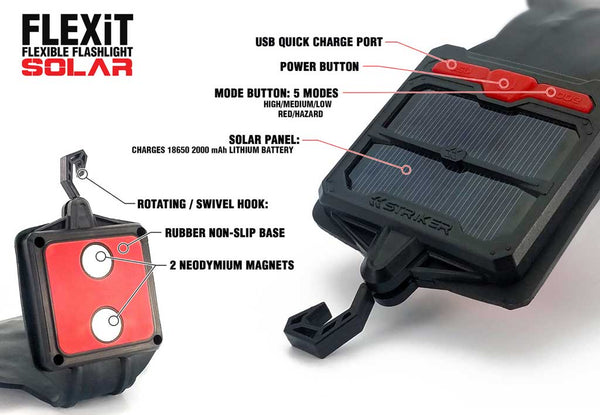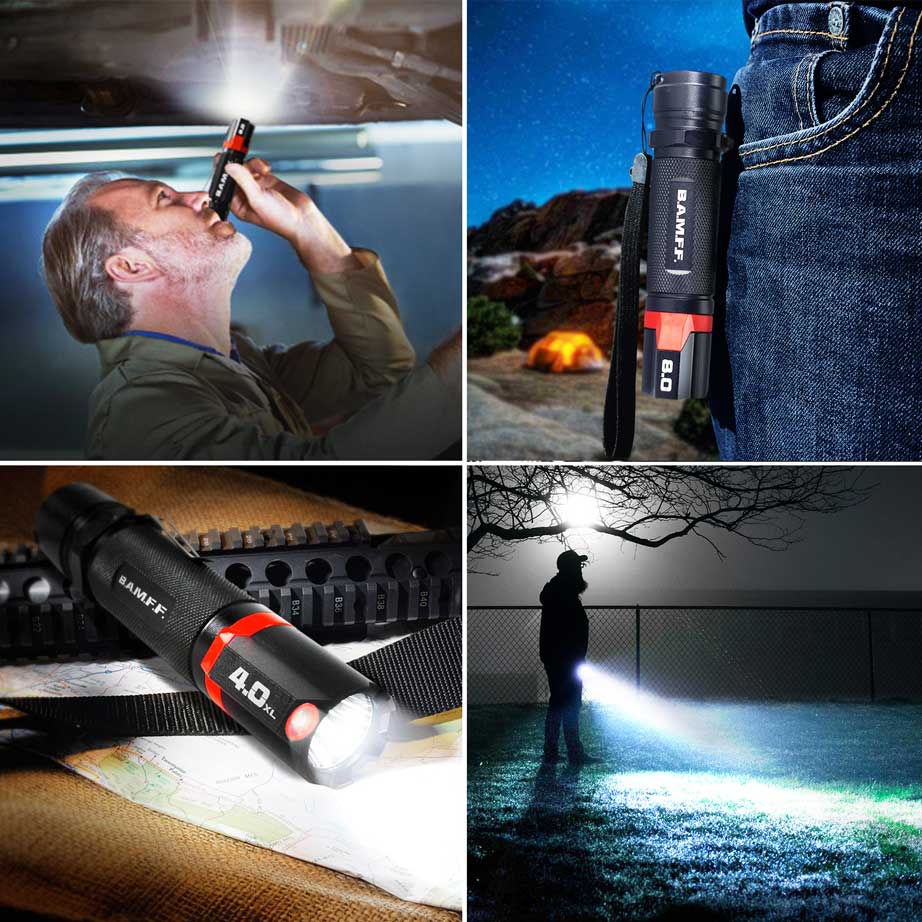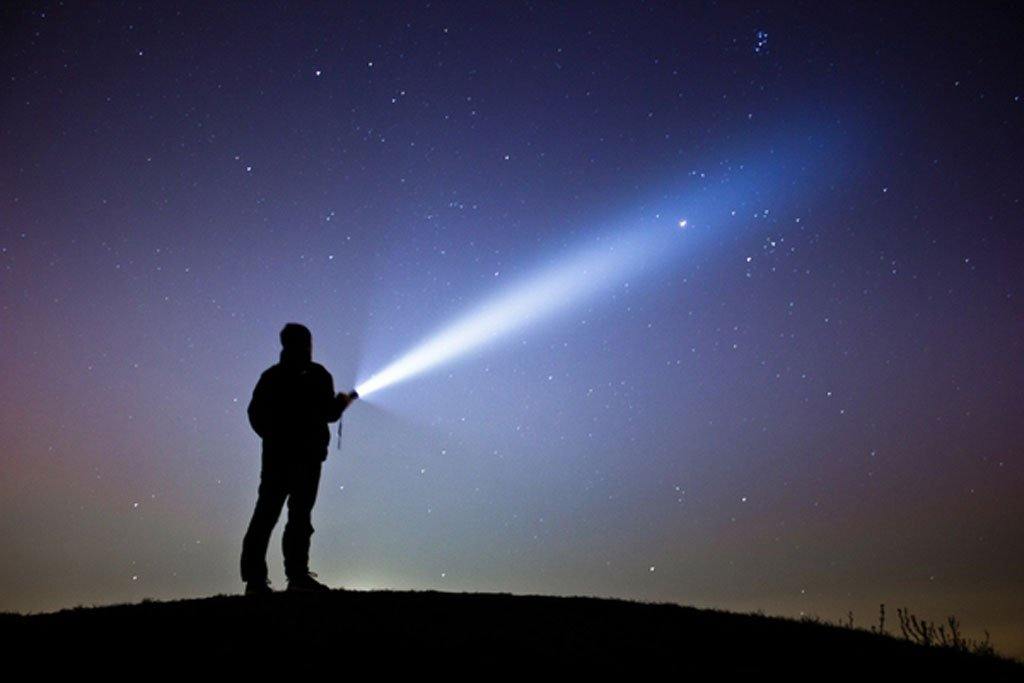
How to Choose a Flashlight: Ultimate Buyer's Guide
Share
Do you want to buy a flashlight, but you aren't sure where to begin? Are you confused about the many types, features, and functions that flashlight companies offer? If so, check out this ultimate guide!
When choosing a flashlight, you should consider the flashlight's type, features, lumen count and cost. You also need to decide why you are getting the flashlight to determine which features are necessary. Some important features to consider include light output, battery type, modes, and more.
Below, we will help you sort the specific flashlight that is just right for you.

Choose the Right Flashlight Category
Flashlights come in three categories, including general-purpose, industrial, and tactical. The first step when choosing a flashlight is to determine which flashlight category is right for you.
General-purpose flashlights
General-purpose flashlights are for everyday use. They are easy to find since many retailers sell them. They can be used for various purposes, including nighttime walks, hikes, finding things in your attic, fixing things around the house, power outages, and more.

They tend to be handheld, lightweight, and fairly inexpensive (depending on their quality).
Industrial flashlights
Industrial flashlights are used in warehouses and industrial buildings. They are designed to operate safely around hazardous materials.

Each industrial flashlight comes with a safety rating that lets the buyer know which hazardous materials it is safe to be around. This is often called an “intrinsically safe” flashlight. Use one of these rated flashlights if you need to make sure your flashlight will be safe in your facility to avoid causing an explosive or a chemical reaction!
Flashlight safety standards are categorized into four sections: classes, divisions, groups, and temperature codes.
- Classes indicate types of hazardous materials that, when present, could cause an explosion.
- Divisions tell you how likely it is for an explosion to occur. Division 1 means that hazardous material is expected to be present during everyday operation. Division 2 means that the hazardous substances will only be present if there is an accident, like if something ruptures or breaks.
- Groups identify the specific elements present that can cause an explosion.
- Temperature codes tell you the maximum temperature the equipment can reach for safe usage. If the equipment's temperature gets too high, it can cause hazardous materials to ignite when they come into contact with the equipment.
If you'd like to see the safety standard charts, Flashlight University has them posted on their website.
Tactical flashlights
Tactical flashlights are used by police officers, security guards, firefighters, hunters, search and rescue teams, and for personal defense. These flashlights are great for safety personnel since they are lightweight and easy to maneuver, so they can be used while also handling a weapon.
Tactical flashlights are great for self-defense. They typically produce a lot of light, which can temporarily disorient attackers. If you are being attacked at night, shining a bright light on your attacker can dissuade him from approaching you since he no longer has the element of surprise.
Tactical flashlights tend to be more expensive than general-purpose flashlights because they are usually made with high-quality materials and are brighter than your average flashlight.
Determine the Purpose of Your Flashlight
Now that you've decided on the general category your flashlight will fall under, you'll want to think about what specific activities you'll use it for. This will help you determine which features you will need.
For example, if you plan to get a tactical flashlight for personal defense and hunting, you'll want to make sure it is light enough to use while holding an additional weapon, with a light output that is strong enough to disorient an attacker.
Or maybe you want a general-use flashlight for your upcoming fishing trip. Now you'll need to find a flashlight with a strong light output that is also water-resistant.
Thinking about your flashlight's main purpose is important because it'll help you decide which features are necessary when you make your purchase.
Decide on a Budget
Flashlights vary widely in price. They can cost anywhere between $20-$200 (or more) depending on how many features they have, their light output, and their overall quality.
Before you purchase your flashlight, you should decide on a budget. Determining a price range will help you narrow down your options when its time to buy.
When you buy your flashlight, ask the store attendant for flashlights in that price range or, if purchasing online, adjust the price range on the website to see which options are available within your budget.
Think About What Kind of Lighting You’ll Need
The amount of light a flashlight produces is the most important feature to consider when making your purchase! Below you'll learn about light output, beam type, and bulb types, which will influence how bright your flashlight can shine.
Light output
Your flashlight's light output is determined by how many lumens it emits. Lumens are the total amount of visible light coming from a light source, such as a flashlight. The more lumens your light source has, the brighter it will be!
The lumens in flashlights can range from about 5 to 3000.
A flashlight with lumens in the 1-25 range would be effective for close-up activities that don't require that much light, such as reading a book.
A flashlight with 100 lumens would suffice for most common indoor activities, such as inspecting a breaker box during a power outage, or kids reading a book at night in their homemade tents.
Tactical flashlights tend to have at least 120-250 lumens. 120 lumens is the minimal amount needed to disorient attackers with your light. Having 250+ lumens enhances your clarity, allowing you to see things significantly better in the dark, which is important for law enforcement officials and search and rescue teams.
3000 lumens is incredibly bright. This amount of lumens is used for high-intensity discharge (HID) headlights, which are the bright bluish-white colored lights you may see coming from other cars at night. However, flashlights truly generating this many lumens will be on the larger size of the flashlight range. They need to hold larger capacity batteries for a reasonable run time, and will need large heatsinks, or large aluminum bodies to absorb all the heat generated by creating this amount of light.
When purchasing a flashlight, looking at how many lumens it emits is a good first step when determining how bright it will be. However, other factors, such as beam intensity, bulb type, and battery type can influence your flashlights overall light output.
Beam type
There are three common beam types, including:
- Flood flashlight beams allow you to see things that are close to you. This type of beam is wide, brightening up everything within your general vicinity. While this beam type is great for seeing things nearby, it is not effective for seeing things that are further away.
- Spot flashlights produce a long beam. This allows them to light up things that are hundreds of feet away. This type of beam is great for brightening up specific areas in the distance.
- Adjustable flashlight beams are the best of both worlds. You can make the beam wide, focused, and everything in between! The versatility of this beam type allows you to use this kind of flashlight for a wide variety of purposes.
- Mutli-beam flashlights offer more than one beam type on one flashlight. The beams can be used at the same time or independently. This is great if you want to light the immediate area and off in the distance at the same time. This style of lighting was pioneered by STKR Concepts and their B.A.M.F.F. line of Dual LED Flashlights.
Bulb type
Most bulbs nowadays are LEDs. Occasionally you can still find incandescent bulbs, but LED's are truly the best. They are energy efficient, resistant to impact, very bright, and have a long run time, making them the perfect bulb for your flashlight.
Select a Battery
Batteries differ depending on their type, longevity, and run time.
Battery Type
The different types of batteries are:
- Alkaline batteries are the classic batteries most people are familiar with. They come in AA, AAA, 9 volt, D cell, and C cell. Although they are cheap and easy to find, their voltage is pretty low, typically ranging from 1.2v - 1.5v. This means they aren't strong enough to power high output flashlights. Therefore, only low-end to mid-range flashlights tend to be powered this way.

- Lithium batteries are small and very efficient. They come in two varieties, rechargeable or non-rechargeable.

The non-rechargeable variety is called CR123A. They are very powerful and can power high-end flashlights. However, they run out of juice fairly quickly, so you'll need to replace them frequently.
Rechargeable lithium batteries are referred to as Lithium-Ion batteries. These are powerful and rechargeable, typically lasting two years or more before they need to be swapped out. Some common models include the 14500, 16340, 18650, 26650. These are typically more expensive than the non-rechargeable kind, costing upwards of $10.
Renewable batteries are ideal for emergency survival kits. These include batteries that can be recharged by a hand crank, solar power, or faraday flashlights that you shake to produce light. The FLEXIT Solar Flexible flashlight has dual charging including solar charging making it a great choice for situations when electrical power to recharge may not be available or attainable.
Battery longevity
A battery's longevity depends on the battery type. While renewable batteries may last up to 2 years, non-renewable batteries need to be switched out every few months or so, depending on how frequently you use the flashlight. They need to be charged and discharged on a regular basis, or they will lose efficiency.
Battery run time
How long your battery will run, called the run time, is measured in hours. Run time refers to how long it will take the light output of your flashlight to drop by 10% of what it typically produces.
Some flashlights will have a consistent light output, which will suddenly decrease. Others will have small decreases in light output over time.
The light mode influences your battery’s run time. If you consistently run your flashlight in "bright mode," the run time will be shorter than if used in a lower mode.
Also, flashlights with higher lumens tend to have a shorter run time than those with lower lumens, so consider that when you are making your purchase.
Choose the Size, Weight, Shape, and Material
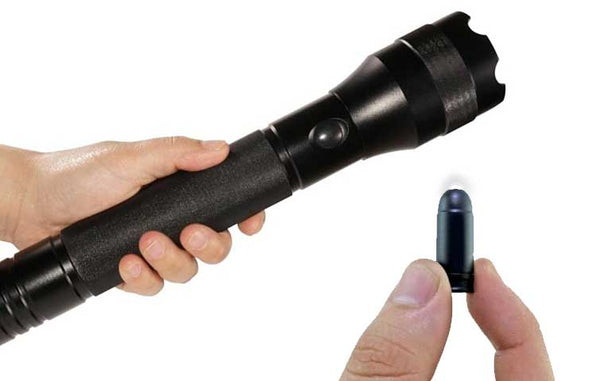
Size and weight
You should select a flashlight that is a good size and weight for the activities you plan to use it for.
For example, if you plan to carry your flashlight for many hours, you'll likely want to purchase a small and light flashlight, since these features will provide it with greater portability.
Large flashlights are heavier and bulkier than small flashlights making them more difficult to maneuver. However, they do have some advantages, including greater durability, brightness, and beam distance. They also tend to have a greater battery capacity since their larger size means more room for batteries. This allows them to have a longer run time. They also don’t generate as much heat because their large bodies absorb the heat better than small, high-output, flashlights (small low powered flashlights don’t generate much heat).
However, many flashlight companies nowadays have designed small flashlights that are nearly as powerful as their larger competitors. So while larger flashlights can be more powerful than smaller flashlights, this isn't always the case.
Make sure to compare the specs of each flashlight you are considering before automatically purchasing the larger one!
Shape
Flashlights tend to be a cylindrical shape, meaning they are prone to roll.
Some flashlight companies add features to the flashlight's bodies to prevent them from rolling around, such as bumps or knurled patterns. These anti-roll features may be useful during activities where the flashlight would typically move around a lot, such as boating.
Some flashlight companies get rid of the cylindrical shape completely, providing you with a flashlight that won't roll at all (more about this below)!
Material
When it comes to flashlight material, most are made from plastic or aluminum alloy. As a bonus, some flashlights have stainless steel heads to provide additional impact resistance.
Flashlights made with aluminum bodies are not always the same. When a flashlight has a thinner aluminum body, it tends to be lighter, whereas thicker ones are heavier but stronger, and absorb more heat.
Determine if You’ll Need Extra Protection
If you plan to use your flashlight outdoors or in situations where you are likely to drop it, you may need extra protection.
Some flashlights offer water resistance and impact resistance. These features help safeguard the flashlight.
Impact resistance
The impact resistance of a flashlight is determined by how many meters you can drop it without breaking.
A flashlight's impact resistance is tested by dropping it from a certain height six times. This ensures that the flashlight can occasionally be dropped and still function. The height at which you can drop your flashlight without breaking it depends on its quality.
Aluminum is often used to make the bodies of impact-resistant flashlights. But this can vary, so make sure to read up on the flashlight you plan to buy to determine whether it is impact resistant.
Water resistance
Water-resistance is an important feature for a flashlight, especially if you plan to use it for outdoor activities, such as camping, boating, fishing, hiking, and more.
The water-resistance of flashlights is rated using the IPX system. Listed below are the most common IPX levels you will encounter:
- 0: No water resistance
- IPX4: Splash resistant, meaning the flashlight can get wet but not fully submerged.
- IPX7: The flashlight can experience temporary submersion for about 30 minutes at 1 meter.
- IPX8: The flashlight can be submerged for up to 4 hours! The depth at which it can be submerged varies.
Think About Modes
Many flashlights, especially general-use flashlights, only come with one mode. However, some flashlights offer various modes, such as low, medium, high, and even boost!
Typically people don't need to switch modes that often. However, some mode features, like a strobe light, SOS, or red light mode, may come in handy depending on what you plan to use your flashlight for.
Remember, the brighter the mode, the shorter amount of run time you get.
Some flashlights have a cool feature that allows you to program light modes on your computer, then upload them onto the flashlight using a USB cord.
Decide the Type of Control Switch You Want
In an article by Going Gear (a gear recommendation website), they go over the different types of control switches flashlights typically have. These include:
- Bezel twist: You twist the front of the light, otherwise known as the bezel, to turn it on and off. This type of switch requires two hands to operate.
- Side click switch: This is a switch that is often located on the side of the light. It may be made of rubber to provide greater water resistance. It can be operated with just one hand. Expensive flashlights sometimes have an electronic version of this switch.
- Tailcap switch: This is a switch that looks like a button located at the bottom end of the flashlight. You can press this switch on and off using one hand, most commonly your thumb.
- Tailcap twist: This switch requires you to twist the flashlight's bottom to turn it on and off.
- Membrane press: This switch typically lies below a thin plastic membrane flush with the flashlight body.
- Side slide switch: This is usually a plastic switch that you can push forward and backward to turn it on and off. It is typically featured on inexpensive flashlights and is difficult to waterproof.
- Rotary ring: This switch features a ring that can be twisted to switch the modes of the flashlight or turn it on and off.
Note: Mechanical clicky switches are switches that produce a "click" sound when they are turned on or off. These come in two types, reverse and forward.
- Reverse clicky switches must be fully pressed to turn the light on. If you don't press the switch fully, it will often switch its mode. This type of switch is commonly used for general-purpose flashlights.
- Forward clicky switches can either be lightly pressed for temporary activation or fully pressed for full activation. They are often featured on lights with a separate mechanism to change the light's mode. They are common on tactical lights and are often used by law enforcement professionals.
Pick Out the Right Flashlight
Now that you've decided on your flashlight category and its features, you finally get to pick out your flashlight!
This next section will go over some flashlights made by STKR Concepts that you may be interested in purchasing.

STKR Concepts is an innovative company that generates products unlike any other. All of their products are researched, designed, and tested by experts who are dedicated to providing users with the optimal experience. Everything they create is engineered to be reliable in demanding work conditions.
STKR makes a lot of lighting systems, including garage lights, headlamps, and more. All of their lighting products are phenomenal, but this article is about flashlights so we’ll focus on those!
Their flashlights are simply the best of the best. They include advanced LED technology, providing users with the brightest and most efficient lighting available. Each flashlight is built with functionality in mind so they will work effectively in any number of situations.
Below we will go over four different STKR flashlights in detail. Make sure to select the flashlight that is best suited for your needs, based on its category, features, and price.
STKR FLEXIT 2.0
The FLEXIT 2.0 is an all-around amazing flashlight that works perfectly in several situations, including while camping, hiking, fixing things around the house, and more!
The FLEXIT 2.0 has a flexible frame, meaning its body is not cylindrical like most flashlights are. Instead, its frame is bendable, allowing you to angle the light any way you choose, providing you with highly customizable lighting. Once you get it in the position you want, its durable Shape-Loc frame will hold the light in place!
This flashlight has 200 lumens and features four light modes, including:
- Low
- Medium
- High
- Hazard
Its base includes two heavy-duty magnets that allow users to stick it to any steel surface. It also has a durable hook that allows you to hang the light if using the magnet is not an option. So, no matter where you are, you will always be able to use this light hands-free!
This flashlight costs $29.99 on STKR’s website.
FLEXIT 4.0
The FLEXIT 4.0 includes all of the fantastic features from the 2.0, and more!
Like the 2.0, the FLEXIT 4.0 has a flexible frame and numerous hands-free options.
Its adjustable frame allows users to angle the light in any number of directions, so you will always get the lighting you need.
This flashlight can be bent, hooked, or wrapped around just about anything, providing you with entirely hands-free usability. It also features a magnetic base.
This incredible flashlight offers 400 lumens and five light modes, including:
- High spot and flood
- High flood
- Low flood
- Red night vision
- Strobe
The FLEXIT 4.0 offers up to 70 hours of runtime and is water-resistant, making it the perfect tool for any outdoor (or indoor) excursion.
This handy dandy flashlight costs $39.99 on the STKR website.
STKR FLEXIT Solar Flashlight
This is my favorite flashlight, hands down. It is versatile, easy to use, and completely weather resistant.
It comes with 500 lumens and three different beam types, including a spotlight, floodlight, and a lantern with a 360° output! These features make this flashlight useful in any number of situations.
Like the other FLEXIT flashlights on this list, the STKR FLEXIT Solar is entirely hands-free. It also features a magnetic base and hook.
This flashlight comes with built-in rechargeable lithium-ion batteries. These can be recharged via sunlight or through a USB cable. This is a great feature for camping or other activities where you may not be around charging outlets.
The FLEXIT Solar flashlight costs $49.99.
B.A.M.F.F. Dual LED Tactical Flashlights
B.A.M.F.F tactical flashlights are incredible torches that will meet all of your safety needs.
The B.A.M.F.F. series offers six different flashlight models that range in lumens from 200-1000. The starting cost of a B.A.M.F.F. flashlight is $29.99.
You may be wondering, what does B.A.M.F.F. stand for anyhow? Well, B.A.M.F.F. means, "Broad Array Multi Flood Flashlight.”
These flashlights were given this name because they feature a powerful spotlight and a broad floodlight. These dual LEDs provide you with the best of both worlds when it comes to visibility!
Whether you want to see far into the distance or see things in your immediate vicinity, these flashlights have your back.
A unique feature of the B.A.M.F.F. dual LED flashlights is that you can use the spotlight and flood features at the same time. This means you no longer have to choose whether you want to see what’s close to you or what’s in the distance. You can do both!
These tactical lights offer six different modes including:
- High spot and flood
- High spot
- High flood
- Low flood
- Strobe
- SOS
The strobe and SOS modes are useful during emergencies in which you need to signal others for help.
If you’d like to observe these incredible flashlights in action, check out this video by STKR. In the video, they go over all of the B.A.M.F.F. flashlights’ amazing features and how they outshine their competition! They also illustrate the differences between the six models they offer.
Buy the Flashlight
You did it! You've decided on the type of flashlight you want, decided on which features you'll need, picked out your flashlight model, and made your purchase. Now there is nothing left to do but use your flashlight!
Final Thoughts
When choosing a flashlight, it is important to consider the type, features, and price of the torch. Some popular flashlight models include STKR FLEXIT 2.0, STKR FLEXIT 4.0, STKR FLEXIT Solar, and the B.A.M.F.F. Dual LED Tactical Flashlights. The most important thing to remember is your flashlight's purpose, as this will help you determine which features are necessary.
I hope this guide helped you find the perfect flashlight!
